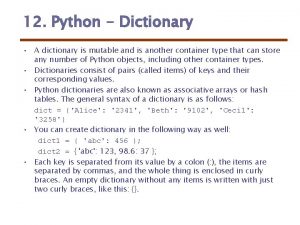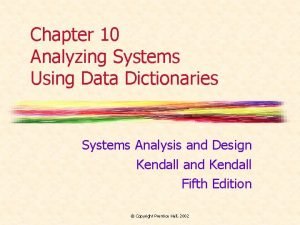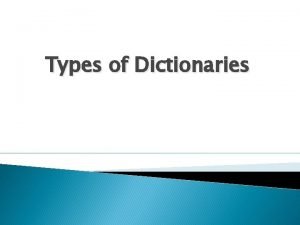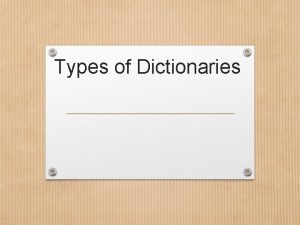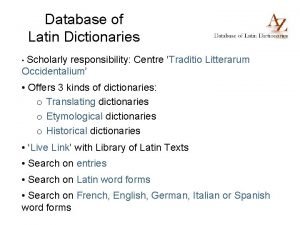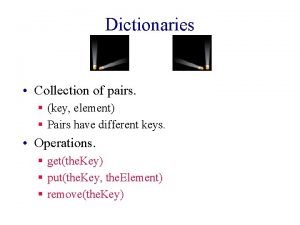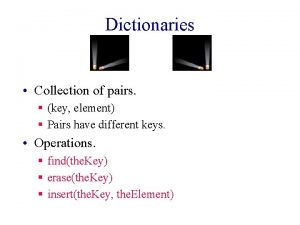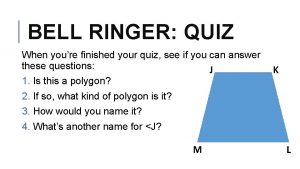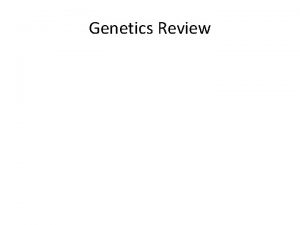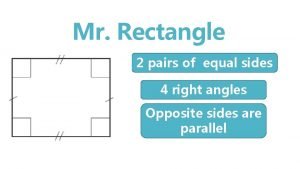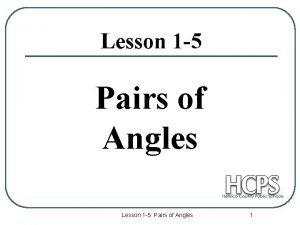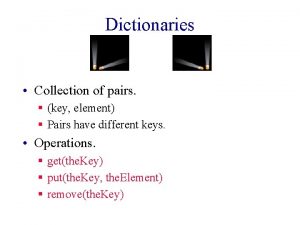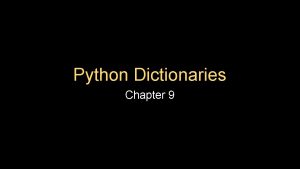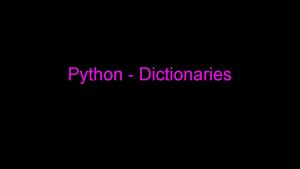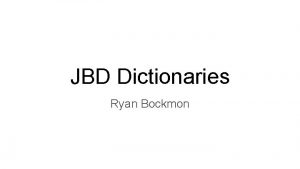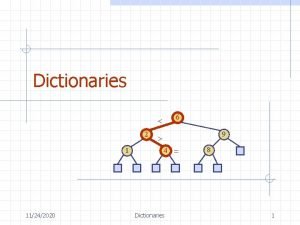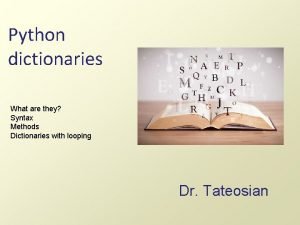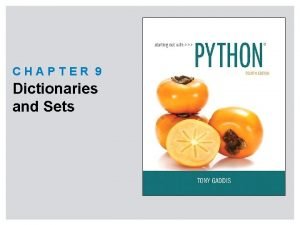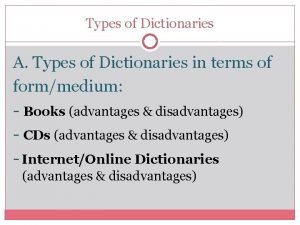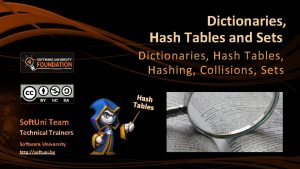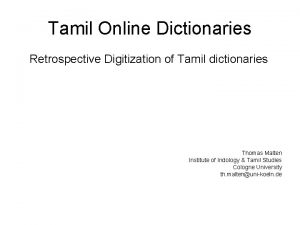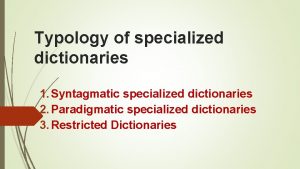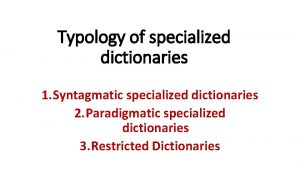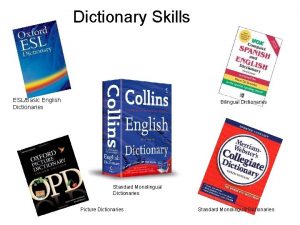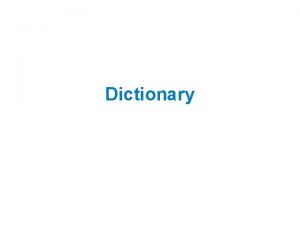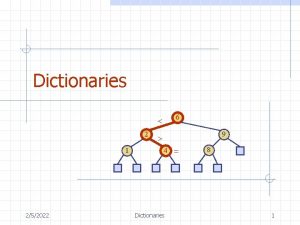Dictionaries Collection of pairs key element Pairs have











![Ideal Hashing • Uses a 1 D array (or table) table[0: b-1]. § Each Ideal Hashing • Uses a 1 D array (or table) table[0: b-1]. § Each](https://slidetodoc.com/presentation_image/cec2ef708b99a133a3841edd99bf1d86/image-12.jpg)

![What Can Go Wrong? (3, d) [0] (22, a) (33, c) [1] [2] [3] What Can Go Wrong? (3, d) [0] (22, a) (33, c) [1] [2] [3]](https://slidetodoc.com/presentation_image/cec2ef708b99a133a3841edd99bf1d86/image-14.jpg)





![Map Into A Home Bucket (3, d) [0] (22, a) (33, c) [1] [2] Map Into A Home Bucket (3, d) [0] (22, a) (33, c) [1] [2]](https://slidetodoc.com/presentation_image/cec2ef708b99a133a3841edd99bf1d86/image-20.jpg)
![Uniform Hash Function (3, d) [0] (22, a) (33, c) [1] [2] [3] (73, Uniform Hash Function (3, d) [0] (22, a) (33, c) [1] [2] [3] (73,](https://slidetodoc.com/presentation_image/cec2ef708b99a133a3841edd99bf1d86/image-21.jpg)
![Uniform Hash Function (3, d) [0] (22, a) (33, c) [1] [2] [3] (73, Uniform Hash Function (3, d) [0] (22, a) (33, c) [1] [2] [3] (73,](https://slidetodoc.com/presentation_image/cec2ef708b99a133a3841edd99bf1d86/image-22.jpg)





- Slides: 27

Dictionaries • Collection of pairs. § (key, element) § Pairs have different keys. • Operations. § find(the. Key) § erase(the. Key) § insert(the. Key, the. Element)

Application • Collection of student records in this class. § (key, element) = (student name, linear list of assignment and exam scores) § All keys are distinct. • Get the element whose key is John Adams. • Update the element whose key is Diana Ross. § insert() implemented as update when there is already a pair with the given key. § erase() followed by insert().

Dictionary With Duplicates • Keys are not required to be distinct. • Word dictionary. § Pairs are of the form (word, meaning). § May have two or more entries for the same word. • (bolt, a threaded pin) • (bolt, a crash of thunder) • (bolt, to shoot forth suddenly) • (bolt, a gulp) • (bolt, a standard roll of cloth) • etc.

Represent As A Linear List • L = (e 0, e 1, e 2, e 3, …, en-1) • Each ei is a pair (key, element). • 5 -pair dictionary D = (a, b, c, d, e). § a = (a. Key, a. Element), b = (b. Key, b. Element), etc. • Array or linked representation.

Array Representation a b c d e • find(the. Key) § O(size) time • insert(the. Key, the. Element) § O(size) time to verify duplicate, O(1) to add at right end. • erase(the. Key) § O(size) time.

Sorted Array A B C D E • elements are in ascending order of key. • find(the. Key) § O(log size) time • insert(the. Key, the. Element) § O(log size) time to verify duplicate, O(size) to add. • erase(the. Key) § O(size) time.

Unsorted Chain first. Node NULL a b c d e • findt(the. Key) § O(size) time • insert(the. Key, the. Element) § O(size) time to verify duplicate, O(1) to add at left end. • erase(the. Key) § O(size) time.

Sorted Chain first. Node NULL A B C D E • Elements are in ascending order of Key. • find(the. Key) § O(size) time • insert(the. Key, the. Element) § O(size) time to verify duplicate, O(1) to put at proper pla

Sorted Chain first. Node NULL A B C D E • Elements are in ascending order of Key. • erase(the. Key) § O(size) time.

Skip Lists • Worst-case time for find, insert, and erase is O(size). • Expected time is O(log size). • We’ll skip lists.

Hash Tables • Worst-case time for find, insert, and erase is O(size). • Expected time is O(1).
![Ideal Hashing Uses a 1 D array or table table0 b1 Each Ideal Hashing • Uses a 1 D array (or table) table[0: b-1]. § Each](https://slidetodoc.com/presentation_image/cec2ef708b99a133a3841edd99bf1d86/image-12.jpg)
Ideal Hashing • Uses a 1 D array (or table) table[0: b-1]. § Each position of this array is a bucket. § A bucket can normally hold only one dictionary pair. • Uses a hash function f that converts each key k into an index in the range [0, b-1]. § f(k) is the home bucket for key k. • Every dictionary pair (key, element) is stored in its home bucket table[f[key]].

Ideal Hashing Example • • Pairs are: (22, a), (33, c), (3, d), (73, e), (85, f). Hash table is table[0: 7], b = 8. Hash function is key/11. Pairs are stored in table as below: (3, d) [0] (22, a) (33, c) [1] [2] [3] (73, e) (85, f) [4] [5] • get, put, and remove take O(1) time. [6] [7]
![What Can Go Wrong 3 d 0 22 a 33 c 1 2 3 What Can Go Wrong? (3, d) [0] (22, a) (33, c) [1] [2] [3]](https://slidetodoc.com/presentation_image/cec2ef708b99a133a3841edd99bf1d86/image-14.jpg)
What Can Go Wrong? (3, d) [0] (22, a) (33, c) [1] [2] [3] (73, e) (85, f) [4] [5] [6] [7] • Where does (26, g) go? • Keys that have the same home bucket are synonyms. § 22 and 26 are synonyms with respect to the hash function that is in use. • The home bucket for (26, g) is already occupied.

What Can Go Wrong? (3, d) (22, a) (33, c) (73, e) (85, f) • A collision occurs when the home bucket for a new pair is occupied by a pair with a different key. • An overflow occurs when there is no space in the home bucket for the new pair. • When a bucket can hold only one pair, collisions and overflows occur together. • Need a method to handle overflows.

Hash Table Issues • Choice of hash function. • Overflow handling method. • Size (number of buckets) of hash table.

Hash Functions • Two parts: § Convert key into a nonnegative integer in case the key is not an integer. • Done by the function hash(). • Map an integer into a home bucket. § f(k) is an integer in the range [0, b-1], where b is the number of buckets in the table.

String To Integer • Each character is 1 byte long. • An int is 4 bytes. • A 2 character string s may be converted into a unique 4 byte non-negative int using the code: int answer = s. at(0); answer = (answer << 8) + s. at(1); • Strings that are longer than 3 characters do not have a unique non-negative int representation.

String To Nonnegative Integer template<> class hash<string> { public: size_t operator()(const string the. Key) const {// Convert the. Key to a nonnegative integer. unsigned long hash. Value = 0; int length = (int) the. Key. length(); for (int i = 0; i < length; i++) hash. Value = 5 * hash. Value + the. Key. at(i); return size_t(hash. Value); } };
![Map Into A Home Bucket 3 d 0 22 a 33 c 1 2 Map Into A Home Bucket (3, d) [0] (22, a) (33, c) [1] [2]](https://slidetodoc.com/presentation_image/cec2ef708b99a133a3841edd99bf1d86/image-20.jpg)
Map Into A Home Bucket (3, d) [0] (22, a) (33, c) [1] [2] [3] (73, e) (85, f) [4] [5] [6] • Most common method is by division. home. Bucket = hash(the. Key) % divisor; • divisor equals number of buckets b. • 0 <= home. Bucket < divisor = b [7]
![Uniform Hash Function 3 d 0 22 a 33 c 1 2 3 73 Uniform Hash Function (3, d) [0] (22, a) (33, c) [1] [2] [3] (73,](https://slidetodoc.com/presentation_image/cec2ef708b99a133a3841edd99bf1d86/image-21.jpg)
Uniform Hash Function (3, d) [0] (22, a) (33, c) [1] [2] [3] (73, e) (85, f) [4] [5] [6] [7] • Let key. Space be the set of all possible keys. • A uniform hash function maps the keys in key. Space into buckets such that approximately the same number of keys get mapped into each bucket.
![Uniform Hash Function 3 d 0 22 a 33 c 1 2 3 73 Uniform Hash Function (3, d) [0] (22, a) (33, c) [1] [2] [3] (73,](https://slidetodoc.com/presentation_image/cec2ef708b99a133a3841edd99bf1d86/image-22.jpg)
Uniform Hash Function (3, d) [0] (22, a) (33, c) [1] [2] [3] (73, e) (85, f) [4] [5] [6] [7] • Equivalently, the probability that a randomly selected key has bucket i as its home bucket is 1/b, 0 <= i < b. • A uniform hash function minimizes the likelihood of an overflow when keys are selected at random.

Hashing By Division • key. Space = all ints. • For every b, the number of ints that get mapped (hashed) into bucket i is approximately 232/b. • Therefore, the division method results in a uniform hash function when key. Space = all ints. • In practice, keys tend to be correlated. • So, the choice of the divisor b affects the distribution of home buckets.

Selecting The Divisor • Because of this correlation, applications tend to have a bias towards keys that map into odd integers (or into even ones). • When the divisor is an even number, odd integers hash into odd home buckets and even integers into even home buckets. § 20%14 = 6, 30%14 = 2, 8%14 = 8 § 15%14 = 1, 3%14 = 3, 23%14 = 9 • The bias in the keys results in a bias toward either the odd or even home buckets.

Selecting The Divisor • When the divisor is an odd number, odd (even) integers may hash into any home. § 20%15 = 5, 30%15 = 0, 8%15 = 8 § 15%15 = 0, 3%15 = 3, 23%15 = 8 • The bias in the keys does not result in a bias toward either the odd or even home buckets. • Better chance of uniformly distributed home buckets. • So do not use an even divisor.

Selecting The Divisor • Similar biased distribution of home buckets is seen, in practice, when the divisor is a multiple of prime numbers such as 3, 5, 7, … • The effect of each prime divisor p of b decreases as p gets larger. • Ideally, choose b so that it is a prime number. • Alternatively, choose b so that it has no prime factor smaller than 20.

STL hash_map • Simply uses a divisor that is an odd number. • This simplifies implementation because we must be able to resize the hash table as more pairs are put into the dictionary. § Array doubling, for example, requires you to go from a 1 D array table whose length is b (which is odd) to an array whose length is 2 b+1 (which is also odd).
 Is dictionary mutable in python
Is dictionary mutable in python Analyzing systems using data dictionaries
Analyzing systems using data dictionaries Types of dictionary
Types of dictionary Types of dictionaries
Types of dictionaries Types of dictionaries
Types of dictionaries Database of latin dictionaries
Database of latin dictionaries Landsat collection 1 vs collection 2
Landsat collection 1 vs collection 2 Documents against payment
Documents against payment I have 6 faces 12 edges and 8 vertices
I have 6 faces 12 edges and 8 vertices Bond angles in octahedral geometry
Bond angles in octahedral geometry No complete element pairs
No complete element pairs No complete element pairs
No complete element pairs Difference between signal element and data element
Difference between signal element and data element Signal element vs data element
Signal element vs data element Customer relationship of business model canvas
Customer relationship of business model canvas Key partners key activities key resources
Key partners key activities key resources Movie task pane adalah
Movie task pane adalah Quadrilateral with no parallel sides
Quadrilateral with no parallel sides Shape that has 2 pairs of parallel sides
Shape that has 2 pairs of parallel sides What did gregor mendel do
What did gregor mendel do Work in pairs imagine that you own a company
Work in pairs imagine that you own a company It is a plate-like of antennae
It is a plate-like of antennae How many pairs of parallel sides does a rectangle have
How many pairs of parallel sides does a rectangle have Atomic number mass
Atomic number mass What are vertical angles
What are vertical angles Unit 2 lesson 5 exploring angles
Unit 2 lesson 5 exploring angles Unit 2 lesson 5 exploring angles
Unit 2 lesson 5 exploring angles A key element to a sucessful training program is
A key element to a sucessful training program is
